
|
Apurina Awiry
|
Apurinã Awiry is a rare green Rapé crafted without Tabaco or ashes. It consists solely of the dried and powdered leaves of Awiry, a sacred plant that grows wild along the banks of the Purus River in Brazil. |
2 Forms |

|
Apurina Awiry Purus
|
This green Rapé is crafted by the Apurinã people from a community nestled along the middle reaches of the Purus River, one of the Amazon’s great tributaries. |
2 Forms |

|
Apurina Verde
|
Apurinã Verde stands apart from most Amazonian Rapés: it contains no Tabaco and no ashes. |
3 Forms |

|
Arara Sanu
|
Arara Sanu Rapé is a potent, spiritually significant snuff blend originating from the Arara tribe in the upper Juruá region of the Amazon Rainforest. |
3 Forms |

|
Caboclo Daime
|
Caboclo Daime is a powerful and refined Rapé crafted by Jesse Nunes de Paula, a Caboclo maker from the Rio Crôa region of Acre, Brazil. |
3 Forms |

|
Clarity 8.0
|
Clarity 8.0 offers an ethereal, sparkling fresh, and pungent yet earthy and grounding flavor. It leaves a lasting olfactory memory with a uniquely sweet chocolate aftertaste. The initial impact is strong and slicing, and it is recommended to use it with moderation, especially for those new to Rapé, as large doses can be intense and shocking. |
3 Forms |

|
Huichol Tagetes lucida
|
This Rapé blend came from a Katukina collaboration between our Brazilian friends and our network of sacred herbs. A nice blend of Corda and Moi Tabaco and Parica ashes, infused with the power of the Huicholi herb called Tagetes Lucida. |
2 Forms |

|
Katukina Bobinsana
|
This is a blend of sensitivity, not force. It encourages heart-centered awareness, emotional resilience, and gentle spiritual grounding. |
3 Forms |
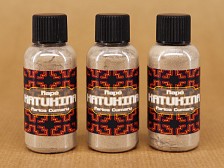
|
Katukina Cumaru
|
Katukina Cumaru Paricá is a deeply cleansing and forceful Rapé crafted by the widow and family of the late Chief Fernando Katukina. |
3 Forms |
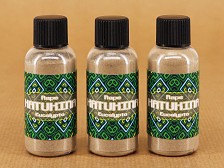
|
Katukina Eucalypto
|
Katukina Eucalypto is a refined and grounded Rapé blend made with organic Moi Tabaco, Pau Pereira ashes, and powdered Eucalyptus leaves. |
3 Forms |

|
Katukina Guayusa
|
Katukina Guayusa is a trans-continental blend, mixing Brazilian Rapé with the Ecuadorian Guayusa plant. The producer of this Rapé added this unique ingredient to a Xixá, Paricá and Arapiraca string Tabaco, to produce a very energetic blend. The caffeine in the Guayusa makes this an energetic mixture, good for working hard, exercise, or staying up late. |
3 Forms |

|
Katukina Mafumeira
|
This is a medium grey Rapè with a wonderful light and uplifting aroma. The name Mafumeira is another name for Samauma or the Kapok tree (Ceiba pentrandra) from which this blend utilises for the ash of its bark. |
2 Forms |

|
Katukina Menta
|
Katukina Menta. It is made with a mixture of organic regional Moi Tabaco and the more potent Corda Tabaco and Tsunu ashes giving a well-balanced base. For the mint they used a mixture of natural mint leaves, crystal menthol and a dab of mint essential oil for the final touch. |
4 Forms |

|
Katukina Menthol
|
Katukina Menthol is a non-tribal Rapé made with deep respect for tradition, using Sabia Tabaco and Tsunu ash, and Menthol crystals. |
3 Forms |

|
Katukina Mulateiro
|
This Rapé is a very fine powder that has a light brown appearance. It provides a sharp initial sensation that has a tendency to immediately make the eyes water. The mind is released of thoughts and one is brought into a peaceful space with a high level of focus. |

|
Katukina Mulungu
|
This Rapé was made with the seeds and ashes of the Mulungu tree as they call it. It is a local sub species of the Mulungu or Coral Tree. It is a great choice for a beginner or a more experienced user that is looking for something more relaxing than intense. It gently tunes one into a more receptive state and doesn't overwhelm one physically leaving the user capable of movement and activity. |
3 Forms |

|
Katukina Parica
|
Parica from the Katukina tribe has wonderful overtones of deep flora within the forest. The powder is of fine quality and is slightly darker grey than usual. On first application it appears supremely powerful, and within a few moments levels out to a deep serenity and clarity. Parica seems to support the sinuses long after use and is good for the mucous membranes. A freshness continues long after the effects have dissipated. Still a very strong variety from the Katukina. |
2 Forms |

|
Katukina Pau Mulata
|
Pau Mulata (also called Mulateiro) has a distinctive aroma of ancient deep forest earth. An exceptional blend from the Katukina. The subtle yet powerful mix of Tabaco and ashes heightens the cerebral state of the user and gently awakens the mental faculties from any dreamy state or lack of concentration. |
2 Forms |

|
Katukina Pau Pereira
|
This Rapè from the Katukina is light brown and very fine and is indicated for meditation or the discharge of energies. Previous Pau Pereira preparations have became known as some of the strongest and most consistent available. This blend from the Katukina is no less powerful. |
4 Forms |
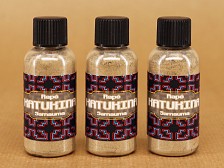
|
Katukina Samauma
|
This particular Rapé features Samaúma ashes combined with Corda Tabaco. The Samaúma tree (Ceiba pentandra), known as the Mother of all trees and the Queen of the Forest, towers above the Amazon rainforest, offering shelter to the plants and creatures below. |

|
Katukina Tsunu Nisural
|
This exceptional blend from the Katukina tribe has a distinctive aroma reminiscent of ancient earth and a sandy, light brown hue. It combines Moi and the stronger variety of Corda Tabaco with Tsunu ashes, which heighten the user's cerebral state and gently awaken mental faculties from any dreamy state or lack of concentration. |
3 Forms |
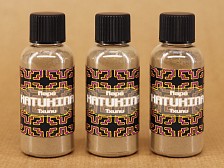
|
Katukina Txunu
|
Txunu from the Katukina tribe has a wonderful subtle effect that brings distractions in the forefront of ones mind to an instant calm. It has a deeply meditative feel to it even though the first moments can be quite sharp and lifting. This only lasts for a few moments before the calmness reaches the entire system. Darker than most grey types this Rapé has its own feel and distinct flavour. |
3 Forms |

|
Kaxinawa Bonatur
|
This preparation of Rapè is made with organic Moi Tabaco and a special herb called Bonatur. An renowned recipe from the Pajé Teta Puã. This Rapè has a most prestigious and wonderful scent as well as a pleasant aftertaste. Not to be missed. |

|
Kaxinawa Cacau
|
Kaxinawá Cacau Rapé is a reddish, forest-crafted blend made by the Huni Kuin using ashes of the wild cacao tree (Theobroma cacao), Sabia Corda Tabaco, and Moi Tabaco. |
3 Forms |

|
Kaxinawa Cacau Forca
|
This powerful Rapé blend from the Kaxinawá tradition is crafted with wild Cacau ashes, Arapiraca Corda Tabaco and Moi Tabaco. |
3 Forms |

|
Kaxinawa Canela do Velho
|
Kaxinawa Canela de Velho Rapé, or simply Canela, is a deeply grounding and potent blend made with Canela de Velho ashes. |
3 Forms |

|
Kaxinawa Caneleiro
|
Caneleiro Rapé is known for the fiery intensity it delivers upon application. The initial sensation is akin to an explosion of energy that clears the mind and opens up the sinuses with a powerful force. This strong burst of energy slowly fades, leaving behind a feeling of deep warmth and groundedness. |
3 Forms |

|
Kaxinawa Cumaru
|
A deeply intense and strong dark style Rapé containing Arapiraca Corda and Tonka Bean Tree (Cumaru) ashes. Cumaru is extremely grounding and has the ability to put the user into deep trance like states. |
3 Forms |

|
Kaxinawa Cumaru de Cheiro
|
A very popular and praized Rapé. The Kaxinawa people are some of the most experimental tribes when it comes to making Rapé: They do not have traditional recipes that would come always as the same, rather they use innumerous plants and different ashes in their mixtures. |
3 Forms |
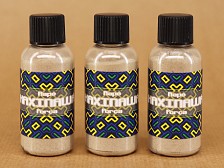
|
Kaxinawa Força
|
Kaxinawá Força Murici is a deeply traditional and widely respected Rapé blend featuring artisanal Arapiraca Corda Tabaco and ashes of the Murici tree. |
3 Forms |

|
Kaxinawa Lourinho
|
Kaxinawa Lourinho, AKA Huni Kuin Nisun. This delightful and rare green Rapé from the Huni Kuin is a special Rapé for medicinal and spiritual use. This Rapé is made with a special undisclosed mixture of local herbs from the Huni Kuin tradition and Sabia Tabaco. This a good Rapé for use in ceremony, when a person gets taken by dizziness or strong unmanagable energies. |
4 Forms |

|
Kaxinawa Moi Cumaru
|
This potent Rapè from the Kaxinawa tribe is a blend of Moi Tabaco (Nicotiana rustica) and ashes from Cumaru bark (Dipteryx odorata). Moi Tabaco is one of the most beautiful of all Rustica types available. The scent is just divine. Moi heightens the senses and helps to put the user into a relaxed state of being. The aftertaste compared to other Tabaco types is sweet and pleasant. |
3 Forms |

|
Kaxinawa Osha
|
This Rapé has a medium-dark grey complexion and has a distinct sharp, warming and bitter aroma imparted by the Osha root, once experienced not forgotten! Osha is one of the most important herbs of the Rocky Mountains, considered sacred by the Native Americans and widely esteemed by them for its broad and effective warm healing power. |
2 Forms |

|
Kaxinawa Uricuri
|
Strong, dark Rapé made by the Hunikuin tribe. Made with Tabaco and the ashes of the Uricuri palm. The Uricuri palm is found only in Acre and used to make spears and arrows. |
3 Forms |

|
Kaxinawa Xacapandare
|
Kaxinawa Xacapandaré is a special gentle recipe with less Tabaco than the usual Rapé. This special blend was discovered by the very respected chief Siã Huni Kuin from the Jordão region, one of the main indigenous leaders from Acre state. Xacapandaré is a very rare and hard to find herb from their tradition. |
3 Forms |

|
Kuntanawa Alfavaca da Mata
|
Kuntanawa Alfavaca da Mata is a cleansing and uplifting Rapé blend prepared by a respected Kuntanawa Rapé maker from the Alto Juruá region. |
3 Forms |

|
Kuntanawa Capim Santo
|
Capim Santo bestows a lasting cerebral effect upon the user. When partaking in smaller doses the effect could be considered similar to gentle streaks of lightning flickering across the frontal lobes. With larger doses the effect is likened to a tropical breeze sweeping across an inner citrus garden, delivering the adept into a minor trance. |
3 Forms |

|
Kuntanawa Corda Tsunu
|
Kuntanawa Corda Tsunu is a potent ceremonial Rapé blend handcrafted by the Kuntanawa family using Sabia, Tsunu, and the aromatic forest herb Apuxuri. |
3 Forms |

|
Kuntanawa Cumaru
|
Kuntanawa Cumaru Rapé is a refined and fragrant blend made with organic Moi Tabaco, ashes from the Sapota tree, and the powdered seeds of Tonka beans / True Cumaru. |
3 Forms |

|
Kuntanawa Flor de Jarina
|
Flor de Jarina Rapé is a celebrated blend from the Kuntanawa tribe, recognised for its unique combination of Moi Tabaco (Fumo de Rolo), Jarina flowers, and Xixá ashes. This blend is particularly valued for its protective qualities. The Kuntanawa believe that the Jarina flowers help make the user invisible to enemies and shield them from harmful energies, both physical and spiritual. |
2 Forms |

|
Kuntanawa Kapaxanba
|
This exclusive Rapé is very aromatic, yet forcefully cleansing and liberating. With any size of dose, sneezing is likely to occur, which seems to be one of the main reasons that the head is cleared of the build up of negative energies, literally blasting out anything that has clogged the internal system. |
2 Forms |

|
Kuntanawa Lourinho
|
This Rapé is another wonderful healer from Pedro Hunivu, master of the plants, from the Kuntanawa people. A Rapé prepared with organic Moi Tabaco and Tsunu ashes. Prepared with Louro, or Lourinho, a local herb name that can be found from region to region. |
2 Forms |

|
Kuntanawa Pedro
|
Pedro Kuntanawa made this particular Rapé. It has a strong inital sting followed by a widening on the nostrils which leads to a calming and relaxed state of being. Its creamy undertones and flowery overtones bring the user into a clear headed state of awareness and the channels feel clean and open to fresh air. |
2 Forms |

|
Kuntanawa Samauma
|
This very special and rare Rapé of the Kuntanawa tribe contains parts and ashes of the Samauma tree. This secret recipe is composed by the shaman of the tribe and contains many sacred and healing plants from the Amazon. |
3 Forms |

|
Kuntanawa Tipy
|
This variety of Rapé has been made by a member of the Kuntanawa tribe and is prepared with a base of local organically grown Tabaco and contains ashes from the Sapota tree. The special character of this Rapé comes from a herb the Kuntanawa call Tipy. Tipy is known to be useful in meditation practices and is widely used by the indigenous for spiritual cleansing. |
2 Forms |

|
Kuntanawa Trevo Cumaru
|
Pedro Kuntanawa made this particular Rapé. Made with a locally produced and harvested organic Moi Tabacco (Nicotiana rustica) and the ashes of Pau Pereira (Tsunu) and a herb locally named Trevo Cumaru. Trevo Cumaru is Pedro´s personal favorite. He uses this herb, considering it a healer that helps to firm the mind, clear negative thoughts and bring inner peace in the spiritual domain. |
2 Forms |

|
Kuntanawa Veia de Paje
|
Kuntanawa Veia de Pajé is a spiritually charged, protective Rapé. It’s meant for those doing focused energetic work. |
3 Forms |

|
Matses Nunu
|
Nunu is a famous and unique snuff coming from the Matse tribe, from the deep Amazonian jungle. Alongside the use of Kambo It is well known for its hunting tool potential. |
3 Forms |

|
Nukini Floresta
|
Nukini Floresta is a well-loved and revitalising Rapé, prepared in the traditional feminine-led style of the Nukini people. |
3 Forms |

|
Nukini Forca
|
This sacred preparation is built around a secretive, time-honored recipe guarded by the women of the tribe for over 12 years. |
3 Forms |

|
Nukini Mulata
|
Nukini Mulata is another beautiful and strong blend created by the Nukini tribe. This preparation offers a fine, sweet and extremely rounded experience, with a high frequency scent of jungle flowers. |
2 Forms |

|
Nukini Trevo Cumaru
|
This Rapé is crafted from a potent and well-balanced combination of Sabia Corda Tabaco, Arapiraca Tabaco, Parika ash (Xinsha), and Trevo Cumaru (Justicia pectoralis). |
3 Forms |

|
Nukini Yemanja
|
Nukini Yemanja is a rare and beautiful Rapé that brings together the grounded force of traditional Nukini medicine with the gentle mysticism of White Roses. |
3 Forms |

|
Orchid Fever 3.0
|
This one of a kind, unique and a famous blend. A famous non-tribal Rapé. Orchid Fever 3.0 is a must-have for the Rapé connoisseur. It has become one of the the most popular blends we have produced. This Rapé is part of the trinity, together with Clarity and Pineal Flush. |
4 Forms |

|
Pataxo Almescla
|
A special Rapé from the Pataxó people is crafted entirely without Tabaco, instead drawing its strength and clarity from the sacred Amescla tree. |

|
Pataxo Laranjeira
|
Rapé crafted by Canduru, a respected Pataxó medicine maker, using leaves of the Laranjeira (the Orange tree) |

|
Pataxo Menta
|
Rapé from the Pataxó people of Brazil featuring a blend of finely ground Mint leaves and Murici ashes. |
2 Forms |

|
Pineal Flush 9.0
|
Pineal Flush 9.0 marks the ninth evolution of one of our most beloved and enduring non-tribal Rapé blends. |
4 Forms |

|
Puyanawa Lourinho
|
Puyanawa Rapé is made with organic Moi Tabaco, Parica ashes and Lourinho. A local herb that the forest people use, a plant with a lush fragrance that opens the nasal passages, while refreshing the mind and clearing the spirit. It is used for spiritual cleansing by the indigenous people of the region. |
2 Forms |

|
Puyanawa Madre
|
Puyanawa Madre Rapé is a powerful and spiritually potent blend, lovingly crafted by the Puyanawa people of Acre, Brazil. |
3 Forms |

|
Puyanawa Murici
|
This Rapé is a simple recipe with "Corda" Tabaco and Murici ashes, the ashes generally used by the Puyanawa. The makers say it is the only ash they use, and say the Rapé becomes stronger and more pleasant to pass. |
2 Forms |
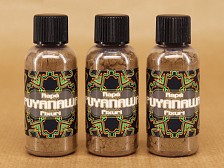
|
Puyanawa Pixuri
|
Puyanawa Pixuri is a brown Rapé blend crafted by a Pajé of the Puyanawa tribe in Acre, Brazil. It features Arapiraca and Sabia Tabaco, Murici ashes, and Pixuri leaves. |
2 Forms |

|
Shanenawa Caneleiro
|
This is a potent and finely crafted Rapé from the Shanenawa tribe of Acre, Brazil. Made using natural Arapiraca Corda Tabaco and the ashes of the Caneleiro tree. |
3 Forms |

|
Shanenawa Floresta
|
This Rapé smells sweet and friendly. Yet, it is amazingly sharp, causing an immediate buzzing pain, and watering eyes. An excellent array of aromas are experienced, sweet, rustic, spicey, almost flowery. Although it looks like a semi brown Rapé, its energy is much like a typical grey Rapé. A high frequency with rich notes and not too heavy on the tobacco. |
3 Forms |

|
Shawadawa Ipe Roxo
|
This exciting new Rapé made with the ashes of Pau D’Arco offers a deeply grounding experience, facilitating introspection. It's praised for its effectiveness in removing energetic blockages and promoting inner clarity. |
2 Forms |

|
Shawadawa Kapayuba
|
Keen, clear, and quietly commanding, this Rapé penetrates with a floral sharpness that strikes directly into the frontal lobes. |
4 Forms |

|
Shawadawa Murici
|
Shawadawa Murici Rapé is a powerful blend crafted from Byrsonima crassifolia (Murici) ashes, revered for their energetic cleansing properties. This Rapé, primarily used by the Shawadawa tribe, is known for its strong grounding effects, helping to release accumulated negative energies, particularly from the lower abdomen. |
2 Forms |

|
Shawadawa Rawaputu
|
The Macaws call themselves Shawadawa, which means the "people of the macaw". This blend is of extremely high quality and frequency with mild subtle jungle tones and... |
3 Forms |

|
Yawanawa Ceremony
|
The Yawanawa Ceremony Rapé is a blend that brings together two powerful spiritual medicines: Tsunu ashes and Jurema ashes, from the Fulni-ô tribe. |
3 Forms |

|
Yawanawa Cumaru
|
This Rapé is one of our classics. A deeply intense and strong Yawanawá style Rapé, containing Tonka Bean Tree ashes. Cumaru is extremely grounding as well as having the ability to put the user into deep trance like states. |
3 Forms |

|
Yawanawa Kapakuru
|
This Yawanawa Rape is named after its creator. Kapakuru is very much respected and liked for his powerful Rapé, as well as his force when blowing the Rapé. |
2 Forms |

|
Yawanawa Moi
|
Yawanawà Moi is a strong and powerful Tsunu type Rapé. "Tabaco de Moi" and Tsunu ashes are the basis of this particular blend. With its own particular flavour and scent, exuding warrior energy and powerful focus upon the user. |
3 Forms |

|
Yawanawa Mulateiro
|
Yawanawá Mulateiro is very strong. It provides a sharp, powerful initial sensation that has a tendency to immediately make the eyes water. It is advisable to take a moment out of time to administer. |
4 Forms |

|
Yawanawa Nawashahu
|
Yawanawa Força Feminina is a rare and sacred Rapé blend crafted by Nawashahu Yawanawa, daughter of Chief Biraci Nixiwaka and the first female shaman of the Yawanawa, Putani. |
3 Forms |

|
Yawanawa Parika
|
Yawanawá Parika is a renowned blend prepared with Sabia Tabaco and the ashes of the Xixá tree, also called Parika or Chicha. |
3 Forms |

|
Yawanawa Pau Mulata
|
A strong and deeply traditional Rapé from the Yawanawá tribe, prepared with Pau Mulata (Mulateiro). Similar in overall composition as the famous Yawanawa Mulateiro, yet more "grey" in appearance and effect. |
2 Forms |

|
Yawanawa Pau Pereira
|
Due to the strength this Rapé has the power to overcome the user, and can lead to an instant detoxification of phlegm and mucus. Watering of the eyes and overwhelming effects are expected. small to medium doses are recommended as larger doses can be intense. |
3 Forms |

|
Yawanawa Peu
|
This Rapé has an immediate "kick" and is the basic Yawanawá Rapé made with Corda Tabaco and Tsunu ashes. It is for us the perfect blend of ashes and Tabaco, non fragrant or spicy and 'clean' in its flavour due to the ash content. It packs a punch. It's initial effects upon application are a powerful yet contained explosion in the sinuses and being of the user. |
3 Forms |

|
Yawanawa Shaneihu
|
Another fine Rapé made by a member of the Yawanawa family! As with most real Yawanawa Rapés the recipe is predictable, it is the classic and as some of the older members of the tribe say the only recipe that truly deserves the name Yawanawa; Tabaco and Tsunu ashes. |
2 Forms |

|
Yawanawa Tonka
|
Yawanawá Tonka Rapé is a unique and distinguished non-tribal preparation that combines Sabia Tabaco, Xixá ashes and the aromatic Cumaru seed, also known as the Tonka bean. |
3 Forms |

|
Yawanawa Tsunu
|
Yawanawá Tsunu Rapé is one of the most traditional blends of the Amazon, prepared with Arapiraca Corda Tabaco and the sacred ashes of the Tsunu tree. |
4 Forms |

|
Yawanawa Tsunu Classic
|
This is not just a Rapé, it is a piece of history. Yawanawa Tsunu Classic was among the very first blends carried beyond the forest by travelers returning from Ayahuasca ceremonies and Yawanawa festivals. |
2 Forms |